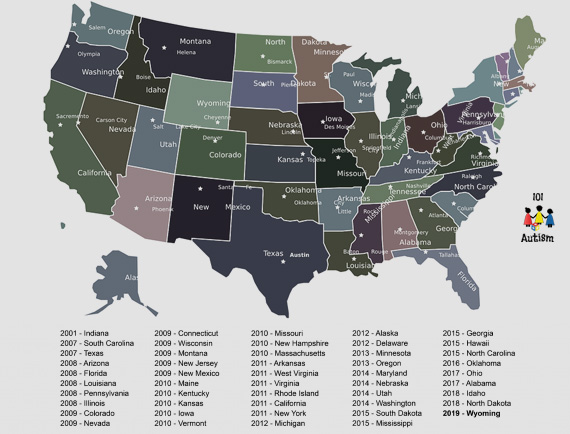Environmental Factors in Autism: New Research Insights [2025 Update]
![Environmental Factors in Autism: New Research Insights [2025 Update]](https://101autism.com/wp-content/uploads/2025/04/20250402_1506_Autism-Research-Insights_simple_compose_01jqv6a26afzesad1e2ymyk1hp-1320x500.png)
Discover how our modern environment may interact with genetics to influence the development of autism spectrum disorder.
- Introduction
- The Gene-Environment Interaction in Autism Development
- Key Environmental Risk Factors for Autism Spectrum Disorder
- Research Evidence: Environmental Triggers Associated with ASD
- Frequently Asked Questions About Environmental Factors and Autism
- Comparing Environmental Factors and ASD Associations
- Key Takeaways: What We Know About Environmental Triggers for Autism
- Conclusion: The Future of Autism Environmental Research
- Additional Resources
Introduction
The prevalence of autism spectrum disorder (ASD) continues to rise globally. Current estimates show that 1 in 36 children are diagnosed in the United States. Improved awareness and expanded diagnostic criteria explain some of this increase. However, researchers increasingly believe that environmental factors may play a significant role in autism development. This is especially true in genetically susceptible individuals.
This comprehensive guide examines the latest scientific evidence on environmental triggers that may contribute to autism risk. By understanding these potential environmental factors, we can work toward better prevention strategies and support for individuals affected by ASD.
The Gene-Environment Interaction in Autism Development
Autism spectrum disorder doesn’t have a single cause. Instead, it emerges from a complex interplay. This involves genetic predisposition and environmental exposures. These interactions occur especially during critical developmental windows from conception through early childhood.
Research shows that environmental factors might influence autism development through several key mechanisms:
- Inducing de novo mutations: Environmental toxins and pollutants may directly damage DNA or impair repair mechanisms, potentially increasing autism risk.
- Amplifying genetic vulnerabilities: Individuals with certain genetic profiles appear more susceptible to environmental exposures. For example, those with variations in tandem repeat DNA motifs might experience heightened sensitivity to toxins.
- Triggering epigenetic modifications: Environmental exposures can alter gene expression without changing DNA sequences through processes like DNA methylation. These epigenetic changes have been linked to ASD development.
- Interacting with parental factors: Advanced parental age correlates with increased ASD risk. This is particularly true for paternal age. The reason is possibly accumulated DNA mutations in sperm cells over time.
“The dramatic increase in autism prevalence cannot be explained by genetics alone,” notes Dr. Irva Hertz-Picciotto, environmental epidemiologist at UC Davis MIND Institute. “Environmental factors must be contributing to this trend, likely by interacting with genetic susceptibilities.”
Key Environmental Risk Factors for Autism Spectrum Disorder
Chemical Factors: Air Pollution and Autism
Multiple studies have identified traffic-related air pollutants as consistent risk factors for autism. Children exposed to higher levels of air pollution during pregnancy show increased rates of ASD diagnosis. Exposure during early life also contributes to higher ASD rates in population studies.
A landmark study published in JAMA Psychiatry found significant results. Children exposed to the highest levels of fine particulate air pollution during pregnancy face a 78% higher risk. This group has an increased chance of developing autism. This risk also applies during the first year of life compared to those with the lowest exposure levels.
Specific chemicals of concern include:
- Fine particulate matter (PM2.5)
- Nitrogen dioxide
- Ozone
- Polycyclic aromatic hydrocarbons (PAHs)
Research also examined pharmaceutical exposures. Vaccines have been extensively studied. They show no association with autism risk. Prenatal exposure to valproate (an anti-seizure medication) is a risk factor identified in multiple studies.
Physiological Factors: Parental Age and Prenatal Conditions
Physiological factors during pregnancy and birth have shown strong and consistent associations with autism risk:
- Advanced parental age: Both maternal and paternal age over 35 years correlates with increased ASD risk. Paternal age shows particularly strong associations.
- Preterm birth and low birth weight: Babies born before 37 weeks gestation or weighing less than 5.5 pounds face higher autism risk.
- Hyperbilirubinemia: Severe jaundice requiring treatment after birth shows links to increased ASD diagnosis.
- Pregnancy complications: A clustering of issues like gestational diabetes, preeclampsia, and maternal infection during pregnancy correlates with higher autism rates.
Dr. Lisa Croen, director of the Autism Research Program at Kaiser Permanente, explains: “These physiological risk factors may create an environment. This environment affects fetal brain development. They may potentially alter neural pathways associated with autism.”
Nutritional Factors: Vitamins and Prenatal Supplements
While less extensively studied than other categories, emerging research suggests maternal nutrition may influence autism risk:
- Vitamin D levels: Several studies show a connection. Lower maternal vitamin D during pregnancy may increase ASD risk in offspring. There may be a correlation between these factors.
- Folic acid supplementation: Research suggests maternal folic acid supplementation before and during early pregnancy. It may provide a protective effect against autism development.
- Omega-3 fatty acids: Preliminary studies suggest that adequate intake of omega-3s during pregnancy might support neurological development. It could potentially reduce autism risk.
Social Factors: Maternal Background and Support
Social determinants of health also appear to influence autism risk:
- Maternal immigrant status: Some studies indicate children of immigrant mothers face higher ASD risk. This may be due to stress, reduced access to healthcare, or other factors.
- Socioeconomic factors: Research shows disparities in autism diagnosis based on socioeconomic status. However, this may relate more to access to diagnosis than true differences in prevalence.
Research Evidence: Environmental Triggers Associated with ASD
A comprehensive scoping review analyzed 315 research articles published between 2003 and 2013. This review provided significant insights into environmental factors associated with autism. The researchers categorized these factors into chemical, physiological, nutritional, and social themes.
Key findings from this review include:
- Traffic-related air pollution emerged as a consistently identified risk factor across multiple studies
- Advanced parental age, preterm birth, and pregnancy complications showed the strongest and most consistent associations with ASD
- Vaccine exposure showed no association with autism development in extensive research
- Nutritional factors like vitamin D and folic acid showed promising but preliminary evidence requiring further research
- Maternal immigrant status appeared as a risk factor in some population studies
More recent research since 2013 has further strengthened these findings, particularly regarding air pollution and advanced parental age. New studies are also exploring gut microbiome disruptions, endocrine-disrupting chemicals, and pesticide exposures as potential contributors to autism risk.
Frequently Asked Questions About Environmental Factors and Autism
Are vaccines linked to autism?
The overwhelming scientific consensus, based on numerous large-scale studies, shows no association between vaccines and autism spectrum disorder. This includes studies specifically examining the MMR vaccine and thimerosal, a mercury-based preservative formerly used in some vaccines.
Can air pollution increase the risk of autism?
Multiple studies suggest that there is a link between exposure to traffic-related air pollutants during pregnancy. Exposure during early life is also associated with an elevated risk of ASD. Children exposed to higher levels of fine particulate matter (PM2.5) and other air pollutants show higher rates of autism diagnosis in population studies.
Does the age of the parents matter for autism risk?
Advanced parental age is a factor in autism risk. Particularly, paternal age over 35 is significant. This may happen because of accumulated de novo mutations in sperm cells over time. Other age-related factors can also affect reproductive health.
Is there a link between diet during pregnancy and autism risk?
Research suggests a potential role for maternal vitamin D levels and folic acid supplementation during pregnancy. Some studies indicate that lower vitamin D levels might associate with higher ASD risk. Adequate folic acid supplementation may have a protective effect.
Are heavy metals a cause of autism?
While some studies have explored heavy metal exposures with ASD, the evidence for a direct causal link remains inconsistent. It is not conclusive. The research review found mixed results in studies examining heavy metal exposures and autism risk.
Comparing Environmental Factors and ASD Associations
Based on the 2003-2013 research review and more recent findings, here’s how different environmental factors compare in their association with autism risk:
| Environmental Factor Category | Specific Examples | Strength of Association | Recent Research Trends |
|---|---|---|---|
| Chemical | Traffic-related air pollutants | Consistent risk factor | Growing evidence strengthens this association |
| Vaccines | No association found | Continued research confirms no link | |
| Prenatal valproate exposure | Risk factor in multiple studies | Now considered a confirmed risk factor | |
| Physiological | Advanced parental age | Consistent risk factor | Increasingly strong evidence, especially for paternal age |
| Preterm birth | Consistent risk factor | Confirmed in multiple follow-up studies | |
| Low birth weight | Consistent risk factor | Dose-response relationship observed | |
| Hyperbilirubinemia | Consistent risk factor | Mechanism research ongoing | |
| Clustering of pregnancy complications | Significant association found | Specific complications being investigated | |
| Nutritional | Lower maternal vitamin D levels | Potential link suggested | More evidence emerging on importance |
| Maternal folic acid supplementation | Potential protective role | Further research confirms benefit | |
| Social | Maternal immigrant status | Risk factor in some studies | Investigation into underlying mechanisms |
Key Takeaways: What We Know About Environmental Triggers for Autism
- Multiple factors work together: Autism likely results from a complex interaction between genetic predisposition and environmental exposures.
- Timing matters: Exposures during specific developmental windows (pregnancy and early childhood) appear most significant.
- Air pollution shows strong evidence: Of all environmental factors studied, traffic-related air pollution shows the most consistent association. It is linked with increased autism risk.
- Physiological factors are important: Advanced parental age, preterm birth, and pregnancy complications consistently associate with higher ASD rates.
- Vaccines do not cause autism: Extensive research has conclusively shown no link between vaccination and autism development.
- Maternal nutrition may play a role: Adequate vitamin D and folic acid intake during pregnancy may influence autism risk.
- More research is needed: We’ve identified several environmental factors associated with autism. However, the precise mechanisms and interactions remain an active area of study.
Conclusion: The Future of Autism Environmental Research
While significant progress has been made in understanding how environmental factors may contribute to autism risk, many questions remain. The precise contribution of specific environmental exposures to the rising prevalence of ASD is still being studied. Their intricate interactions with genetic factors continue to drive research in this field.
Future studies employing comprehensive approaches will be crucial to unravel these complex relationships. These approaches include longitudinal birth cohorts with detailed environmental exposure assessments and genomic sequencing. Understanding these interactions is crucial for strategy development. These strategies aim to mitigate potential environmental risks. They also support individuals and families affected by autism spectrum disorder.
As Dr. Craig Newschaffer, autism researcher at Drexel University, states: “Identifying modifiable environmental risk factors for autism allows us to develop prevention strategies. These strategies could reduce the incidence of ASD. They may also improve outcomes for those at risk.”
Additional Resources
For more information about autism and environmental factors, please explore these reputable resources:
- Autism Science Foundation
- Environmental Factors in Autism Initiative
- Autism Research Institute Environmental Factors Page
This article was last updated on April 2, 2025. New research findings may have emerged since publication.
About the Author: [Insert your bio here]
Have questions about environmental factors and autism? Leave a comment below or sign up for our newsletter to receive updates on the latest autism research.


